







•









•
OCTOBER 2024
Volume 20, Number 6
Founded in 2005 by
Joyce Bruno & Robert Weaver
Publisher and Editor
Robert Weaver Columnists
Ronda Anson
Master Gardener
Abby Lapides
Sugar Creek Gardens
Steffie Littlefield
Edg-Clif Winery
Scott Woodbury
Cacalia Design & Wilding
Samantha Zale
Greenscape Gardens
® When Scott Woodbury sent me his article submission for October, I read it through and paused at his description of prairied dock, Silphium terebinthinaceum, with flower stalks reaching “4-6’” in height. I immediately emailed him and told him his plants were wimps, and enclosed the accompanying photo to show those in my garden towering over my 6’ frame by a good 3-4’! That’s probably a result of my way-too-richfor-prairie-natives garden soil in comparison to the prairie dock’s natural habitat of prairies and fens.
Printing: Breese Publishing, Breese, IL
The Gateway Gardener® is published 7 times/year by Double Dig Communications, Inc. to promote enjoyable, successful gardening and livable landscapes in the St. Louis greater metropolitan area. The magazine is distributed free to the public at designated garden centers, nurseries, garden gift shops, lawn equipment rental, repair and sales establishments, and other locations supporting sound gardening, lawn and landscaping practices.
Please send letters-to-the-editor, questions, event announcements, editorial suggestions and contributions, photos, advertising inquiries and materials, and any other correspondence to:
The Gateway Gardener Magazine® PO Box 220853 St. Louis, MO 63122 Phone: (314) 968-3740
info@gatewaygardener.com www.gatewaygardener.com






But he was spot on about the bold texture the huge leaves provide my native garden. I used it as such after having tried another bold Silphium for that purpose, Cup Plant, (S. perfoliatum), and finding it way too fond of seeding itself around the garden. The prairie dock seeds around a bit, too, but in a much more manageable way. You can read about more of Scott’s bold natives on page 12.
Boldness isn’t always about bigness; sometimes it comes in more compact packages. Flowering shrubs often provide bold bursts of color, but

frequently grow to mature sizes too large for many modern landscapes. Abby Lapides introduces us to a few popular flowering shrubs that now come in smaller versions to accommodate even the most space-challenged gardens. Check them out on page 4. There’s no getting around the need, however, for square footage when it comes to growing vining vegetables like winter squash. A single vine could sprawl over 50-100 sq. ft., according to Steffie Littlefield. But if you have the space, don’t stop at one, Steffie tells us on page 6, as there are a multitude of winter squash varieties, each with its own unique flavor, appearance and culinary appeal.
Finally, we look to the future for bold holiday design and bold bucket-list plans. For fans of traditional holiday floral décor, it’s time to start prepping those amaryllis, Christmas cactus, paperwhites and other winter favorites if the goal is to have them blooming in December. Samantha Zale gives her tips on the matter on page 8. It’s also time to start planning even further into 2024, if your dream is to experience the floral beauty of spring in Europe! Travel expert Nancy Luechtefeld suggests a few flower-ful destinations to check out on page 10.
Back to present (or nearly so), the goldfinches will soon be swaying atop the tall prairie dock stalks, enjoying the bold energy provided by the spent flowers’ seeds and not caring a twit (or tweet) about the bold leaves below. Bolder is in the eye of the beholder.

by Abby Lapides

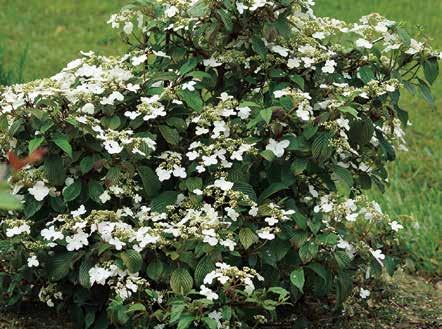
Low maintenance, long blooming, and with a good presence in the garden, mid-sized shrubs add delightful color to the back of a perennial bed. They can also be used to create bold hedges or accents. When planning your garden, try a few to add extra color and excitement to your design.


Weigelas have been a standard bearer for tough shrubs in sunny locations. ‘Peach Kisses’ provides a fun new color and a strong reblooming habit to the weigela family. Warm and fuzzy feelings explode from this adorable weigela loaded with peachy pink flowers. Growing about 3’ tall and wide, ‘Peach Kisses’ has an adaptable size perfect for mixed gardens or smaller locations. For the best reblooming action, give them a light shear after blooming.
One of the longest-blooming Viburnums available is ‘Steady Eddy,’ which flowers for months. The show starts in late spring when it blooms with other doublefile viburnums. It takes just a brief rest and comes roaring back with wave after wave of lacy white blooms throughout the summer into fall – in fact, it’s rarely without flowers in trial gardens. No deadheading is required for continuous bloom. The foliage has an appealing, deeply incised



‘Reminiscent Crema’
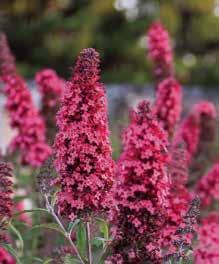
Butterfly Bush
‘Prince Charming’
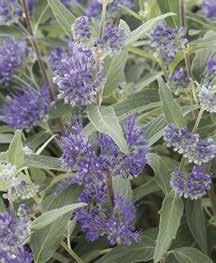
Caryopteris ‘Dark Knight’
texture, and the habit is a landscape-friendly 4-5’ tall and wide. Blooming early summer through fall with puffs of intense fragrance, ‘Reminiscent Crema’ shrub rose will delight your nose and your eyes. Each big, full bloom boasts a very high petal count and a strong, sweet fragrance. The perfect choice for adding classic beauty to the landscape or flower garden! Clean, vigorous growth and foliage, with no deadheading required for continuous bloom.
Nothing beats ‘Bobo’ panicle hydrangea for flower size and bloom time. Massive white fluffy panicles bloom on petite plants. Its flower power and pint-size make it fantastic in containers, as a focal point, or as a small hedge. Bobo’s luscious flowers first appear in July, with blooming continuing into fall. Flowers take on a lovely pink hue in fall. It is very easy to grow in full sun to


part shade.
Unlike any other, ‘Prince Charming’ butterfly bush, Buddleia, produces one-of-a-kind deep cerise-pink flower panicles. A color breakthrough for the genus, its 10” flowers are saturated with rich raspberry-pink hues. At 4’ tall, this mid-sized shrub is the perfect height for a background for perennial borders, for the middle of the border, or as a hedge. Its intensely colored flowers begin to appear in summer. Butterflies, hummingbirds, and other pollinators adore its honey-scented blossoms.
With jewel-toned flowers and drought tolerance, ‘Dark Knight’ bluebeard, Caryopteris, is a must-have for the summer garden. Spikes of intense blue flowers cover ‘Dark Knight’ summer through fall. The flowers are loved by bees and other pollinators – you’ll be delighted as you watch them dance around this nectarrich petite plant. The silvery-green wispy foliage flutters in the wind, adding movement and texture to the garden. Deer, rabbit, and drought resistant.
Once established these shrubs are easy-care, needing to be watered only during dry spells and when budding and flowering.
Abby Lapides is owner and a speaker at Sugar Creek Gardens Nursery. She has degrees from the University of Missouri, and is a member of the Landscape and Nursery Association of Greater St. Louis. You can reach her at (314) 965-3070.


Tips for Growing, Buying and Cooking Fresh, Locally Sourced Food for Your
By Steffie Littlefield

Winter Squash is a funny name for a vegetable we grow in the summer. These squash have many different shapes and colors but all have a harder shell and dense textured pulp inside. This makes them last longer, by not drying out and protecting them from rots. Some varieties will keep through winter, hence the name winter squash. Fun and fancy varieties include
acorn, butternut, carnival, delicata, turban, and spaghetti. Acorn squash is named for its shape, the rind of an acorn squash is dark green, fading to orange. Its yellow-orange flesh is sweet and nutty.
Buttercup is one of the sweetest squashes, very similar in flavor but slightly less complex and rich than a butternut squash. It has a dark green exterior with a dense orange flesh.
Butternuts have a tan skin and orange flesh. They’re sweet and nutty, rich and buttery.

• Mums, Bulbs, Pansies
• Hardy Grasses
• Flowering Shrubs
• Succulents, Bonsai
• Houseplants



The fancy delicata is named for its thin, delicate, edible rind, the oblong, cylindrical delicata squash has a buttery yellow exterior with green stripes running its length. The creamy, pale orange interior is sweet, with a flavor somewhere between a sweet potato and butternut squash.
Carnival is an acorn-sweet dumpling squash hybrid. It’s smaller and squattier than an acorn but can be used in most acorn squash recipes. The exterior color may be similar to a delicata, but the carnival has many more color varieties. They’re always mottled with some light yellow, green and orange tones.
Spaghetti squash is so named because the flesh separates
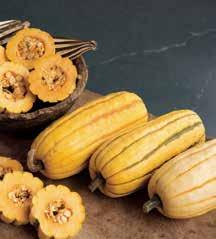

Steffie Littlefield is a St Louis area horticulturist and garden designer. She has degrees from St. Louis Community College at Meramec and Southeast Missouri State and is a member of Gateway Professional Horticultural Association, Missouri Botanical Garden Members Board and past president of the Horticulture Co-op of Metropolitan St. Louis. She is part-owner of Edg-Clif Winery, Potosi, MO. www.Edg-Clif.com.

into spaghetti-like strands when cooked. The exterior is a creamy yellow. It is most commonly halved and roasted. Once cooked, the strands are usually scraped from the rind and served as a simple side dish, perhaps with butter and salt. It’s also popularly paired with traditional pasta sauces.
Turban squash is sweet with a mild, hazelnut-like flavor and a notably dry texture. It’s very large and named for its distinctive headwear-like shape. It may be cooked like other winter squash. The bottom “bowl” of the turban may be scraped out and used for serving soup or stuffed and baked.
Cooking
All of these can be roasted, used in soups, baked into desserts, added to smoothies, or whipped into soufflés.
The rich, sweet pulp is not only delicious but winter squash will deliver Vitamins A and C, antioxidants, fiber and potassium.
When you’re prepping winter squash, don’t ditch the seeds. They can be roasted and also provide nutrients including more fiber, mono- and polyunsaturated fats (the types you want to eat more of), vitamin E, and iron.
growing
Because winter squash requires a long growing season (generally from 75 to 100 frost-free days), the seeds are generally planted by mid May in the Midwest. Direct-sow winter squash
in the ground when all danger of frost is past. The soil temperatures should be at least 6070 degrees F. Squash is very sensitive to cold. Plant squash in a location with full sun and lots of space for sprawling vines. Most full-size winter squash varieties need 50 to 100 square feet to spread. Soil must be well-fed and moist (not soggy), and well-draining. Mix aged manure and/ or compost (about 50% native soil to organic matter) deep into the soil a couple of weeks before planting.
Winter squash are harvested in late summer or autumn, just before or after their fruits reach full maturity.
Another interesting difference in winter squash is that when they are harvested the flesh is primarily starch, but as it sits in storage, the starch converts to sugar. To get the longest storage time from your squash keep 1-2 inches of stem on them to dry. Store in a cool well ventilated location.
Squash is a particularly fun project for the family. Children can help plant the larger seeds, almost watch them sprout in a few days and then marvel as they seem to become super-plants overnight. The flowers are easy to spot and fruit can be monitored as it changes and matures. Even the cooking process is simple enough to involve the whole family. Seeds can be saved and roasted for snacks or dried to plant the next year.
Photos courtesy Baker Creek Heirloom Seed Co. / rareseeds.com


By Samantha Zale

As the chill of winter sets in, houseplants like Christmas Cactus, Paperwhites, and Amaryllis offer a welcome burst of color and life. Each of these plants requires specific care to thrive and bloom beautifully during the holiday season. Here’s
a comprehensive guide to preparing these winter beauties for a vibrant display.
Christmas Cactus with their showy colorful flowers prefer welldraining soil, such as a cactus/succulent potting mix. If you’re in a pinch you can make your own by combining equal parts of potting soil, perlite and sand. Be sure to select a pot with drainage holes to prevent root rot. Find a spot with bright, indirect light because direct sun can scorch the leaves. Interestingly, Christmas Cactus thrives in cooler temperatures when compared to other houseplants with 60-70°F being their ideal temperature range. Make sure they are able to dry out in between waterings and because they like humidity, make sure they aren’t sitting in the line of fire from a fan or air vent. If you’re looking for these to bloom in December, then now is the time for them to begin their







dormant period. Make sure they’re able to get about 1214 hours of darkness (closet, unused room or covered by a box) in a 24-hour period for 4-6 weeks. While in this time frame, refrain from fertilizing them, save that until the spring & summer during their active growth phase.
Paperwhites are popular for their fragrant, white blooms that typically bloom in the winter. When choosing bulbs, select ones that are plump and firm and be sure to pot them into shallow containers. They can grow in either soil or water, making the container possibilities virtually endless. Be sure to maintain good drainage to limit root rot with the help of pebbles or marbles. If planting in soil, fill the container with potting mix, leaving the top third of the bulb exposed. If growing in water, place the bulbs in the container on a bed of pebbles, marbles or gravel, and add enough water to just touch the base of the bulbs. Pick a location that stays relatively cool around 60-65°F with bright indirect light. Avoid placing them in direct sun, which can cause the flowers to wilt prematurely. Water the bulbs regularly. If growing in soil keeping the soil moist but not soggy, or ensuring the water level is consistent if growing in water. Paperwhites typically bloom in 4-6 weeks after planting. If they grow too tall and leggy, you can support them with stakes, especially if they’re in a spot where they might get bumped around.
Amaryllis bulbs are great gifts as they produce large long-lasting flowers and can be tightly potted in soil or the bulb can be waxed. Waxing the bulb increases its longevity since there is no need to water as you would in soil while maintaining proper soil drainage and preventing root rot. If potting in soil be sure to keep the top third of the bulb above the soil line and use a well-draining

potting mix such as ProMix or other premium brand. Like the other plants listed, these need consistent bright light but no direct sun. They can however, handle slightly warmer temperatures of 65-75°F, while again, avoiding drafts from forced air vents. Water regularly to keep the soil moist, but not soggy, and once the flower stalk emerges fertilization can begin, ideally, with a bloom booster type of fertilizer. Amaryllis tend to bloom 6-8 weeks after planting or about 2 weeks after the flower stalk appears. By following these guidelines, you can ensure that your Christmas Cactus, Paperwhites, and Amaryllis are well-prepared to bloom beautifully and bring festive cheer to your home. Each plant has its own unique requirements, but with proper care and attention, they will reward you with stunning, vibrant flowers that brighten the winter months. Remember that the folks at your local garden center are always ready to help! Happy gardening!
Samantha Zale has degrees in Horticulture, Anthropology and Biomedical Science. Over the years she has worked at The Missouri Botanical Garden, garden centers, and The Webster Groves Parks Department. Now you can find her at Greenscape Gardens, where she is a content creator as well as their Retail Manager!


by Nancy Luechtefeld

Many people travel abroad to see the historic architectural wonders of ancient cities or taste the mouth-watering culinary offerings of authentic bistros and cafes. But for many gardeners, tops on their list of reasons for going is the abundant floral beauty waiting to behold. Here are a few BIG destinations that come in relatively SMALL packages. --Ed.
While Holland and Belgium may be small in size, they are home to some of the most magnificent and renowned gardens in the world. They range from the famous tulip displays at Keukenhof Gardens to the impressive floral extravaganzas of Flavoland and Floralia. While each is different in their presentation, they all spotlight the love of flowers the Dutch and Belgians have. Even if you’ve already checked Keukenhof off your bucket list, Flavoland and Floralia are well worth a visit - after all, you can never get enough of beautiful flowers!
And with the proximity of these destinations, visitors can easily experience all three gardens, plus have time to indulge in the countries’ rich culture, history, and delectable culinary offerings as chocolate and beer tastings.
KeuKenhof Gardens: Tulip CapiTal of The World Nestled in the heart of the “tulip region” of Holland, and just outside Amsterdam, Keukenhof Gardens is a true wonder to behold. Open for just 6 weeks each spring, this 79-acre oasis boasts a staggering 7-9 million tulips, daffodils, hyacinths and other spring-flowering bulbs. The flowers are replanted each year in a different design. Visitors can wander through elaborately landscaped flower beds, serene ponds, and whimsical sculptures, all while breathing in the intoxicating fragrance of millions of blooms. Your camera is sure to get a workout here. It’s no wonder Keukenhof is considered the “Garden of Europe” and the ultimate destination for tulip enthusiasts.
flevoland: holland’s iConiC Tulip fields

Just a short drive from Keukenhof, the region known as Flavoland offers another breathtaking display of Holland’s famous tulips. This picturesque area is blanketed with vibrant, undulating fields of tulips in every imaginable color - from classic reds and yellows to more exotic shades of purple, pink, and even black. Just imagine walking through rows of flowers, capturing stunning photographs to remind you of your day amidst such beauty.
floralia: BelGium’s floral exTravaGanza
Holland is not the only country boasting beautiful gardens. Just across the border in Belgium, the town of Groot-Bijgaarden hosts an equally impressive floral display at Floralia. This flower show takes place every spring, featuring elaborate flower beds, greenhouses bursting with blooms, and stunning ornamental fountains. Visitors can stroll through the meticulously landscaped gardens, admire the work of talented floral designers, and even

For those taking a break from the floral attractions, Belgium offers plenty of other attractions to wile away an afternoon.
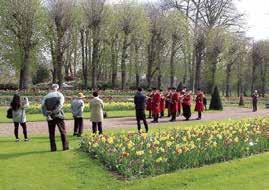
enjoy live music and entertainment. Floralia is a true celebration of the beauty and diversity of the plant world, making it a must-see for any garden enthusiast.
While the gardens of Holland and Belgium might be the main draw for gardeners, these countries also boast a wealth of opportunities for those other reasons people travel abroad: history, culture, wonderful cuisine, and charming cities waiting to be explored.
You can make your own independent travel arrangements and schedule, or join me on an AMA Waterways river cruise next April to visit these beautiful destinations and more! In either case, spring will be here before you know it. So make your travel arrangements today!
Nancy Luechtefeld is the owner of Unique Journeys, LLC, a boutique travel company specializing in small and custom vacations and luxury river cruises. She is currently working with garden clubs and other groups, as well as individuals, to facilitate river tours and land tours that include the trip described here. To find out more, contact Nancy by phone at 314/644-8691, email at nancy@uniquejourneys.com, or visit www.unique-journeys.com.





Don’t have a convenient pickup spot near you, or the rack is empty when you get there? Just complete this form and mail it with $24 for postage and handling to the address below. You will receive 7 issues (a one-year subscription) beginning with the next issue.
To:
Address:
City, State & Zip:
Phone (opt.):
Email (opt.):
Please make your check payable to The Gateway Gardener and mail it with this form to: The Gateway Gardener • PO Box 220853 St. Louis, MO 63122


text and photos by Scott Woodbury


9814 Pleasant Hill Rd Jefferson City MO 65109 www.mowildflowers.net mowldflrs@socket.net 573-496-3492
Meet us at this location in St. Louis.
Give us your order at least five days before the sale, and we will bring it to the Best of Missouri.
Missouri Botanical Garden, 4344 Shaw Blvd. St. Louis, Mo 63110. Event: Best of Missouri Market, Admission charge varies, details: mobot.org
Friday, Oct 4, 12 p.m. - 8 p.m.
Saturday, Oct 5, 9: a.m. - 5 p.m. (members 8-9 a.m.)
Sunday, Oct 6, 9 a.m. - 5 p.m.
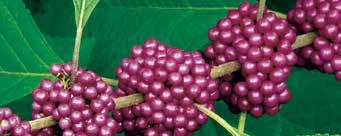
We’re open weekdays, year-round at the nursery (9814 address above) and weekends now until October 16.




Some of the best-looking gardens include plants with big, bold leaves that add dramatic, visual “texture.” Hosta, a plant from Japan, is a good example. Its popularity is founded in its big, bold brush strokes of blue-, yellow-, and white-striped leaves that resemble fancy parasols more than merely mortal, everyday plants. Today, the passion for hosta is still going strong, though there are other, more local bold plants to choose from.
My favorite bold native plant for shade is American spikenard (Aralia racemosa), a member of the ginseng family. In rich, moist soil, its leaves reach parasol-sized proportions and can grow to 4 feet or taller. Planted in more humble clay soils, plants are shorter and leaves are smaller, though still impressive. Its leaves are compound with 3- to 6-inch leaflets—one of the largest and showiest herbaceous plants in the Ozarks. Oh, and it’s a major insect magnet, attracting aphids, ants, bees, flies, beetles, skippers, assassin bugs, jumping spiders, and the occasional praying mantis—a non-finicky ambush predator known to hang out near other insect magnets, like blazing star, mountain mint, and milkweed.

Other big-leaved perennials for shady landscapes include species of Indian plantains or Cacalia (now called Arnoglossum). The biggest of these is pale Indian plantain (Arnoglossum atriplicifolia) often topping out at 5 to 6 feet or more. And then there is prairie Indian plantain (A. plantaginea), which has narrower, glossy leaves like a true plantain. It tends to grow at the edges of rocky woodlands. And finally, my favorite—the great Indian plantain (Cacalia muhlenbergii) with large scallop-shaped basal leaves. This one can’t be beat. For me, Indian plantains are a must-have perennial for all of my shady garden designs,
especially the ones with elbow room. In shady gardens, there are other bold-textured native plants to choose from. Nothing stands out like the antler-like leaves of sensitive fern (Onoclea sensibilus), a creature of moist to average soils. Or ostrich fern (Matteuccia struthiopteris), with leaves like peacock feathers. Ostrich fern is more water-dependent, and both species colonize by rhizomes and prefer growing in rich, moist soil.
Other favorites for shade include Jack-in-the pulpit (Arisaema triphylla), though it often flops in late summer under the weight of bright red berry clusters, and woodland or Virginia knotweed (also known as jumpseed; Persicaria virginiana), whose spikes of small white flowers create a pleasing contrast with its round leaves. And an evergreen ground cover, golden groundsel (Packera aurea), which has bold round leaves on plants 8 to 10 inches tall.
For sunny gardens, I often rely on southern blue flag iris (Iris virginica), for its high-contrasting, spike-like foliage. It blooms nicely, but only briefly, and is a foliage plant for most of the growing season. It has the potential to outgrow its boundaries, needing division after three years.


Scott Woodbury was the horticulturist at Shaw Nature Reserve for 30 years and stepped down from that position in June 2022. He continues to work on contract for Shaw Nature Reserve to carry out native landscaping education and has launched his own business called Cacalia: Native Garden Design and Wilding. Find suppliers of native plants, seeds, and services at the Grow Native! Resource Guide: www. moprairie.org.
tower over giant heart-shaped leaves that add a solid punch of bold texture to any garden, wall, or horizon. I especially like it with a skirt of wirey prairie dropseed grass (Sporobolus heterolepis) or star sedge (Carex radiata). It always becomes a dominant focal point, so locate it next to something else you want to look at: a boulder, sculpture, patio, or a view out the window. Its yellow flowers sit on top of 4- to 6-foot tall stalks. It is a landscape designer ’s best “living accessory” to make a garden truly stands out from the crowd.
Last are bold plants that grow in shallow water (emergent aquatics) in a water garden, large container, or pond. Pickerel plant (Pontedaria cordata), arrow leaf (Sagittaria latifolia), and arrow arum (Peltandra virginica) are the most stunning foliage plants, but they need to grow in permanent shallow water, ideally less than 18 inches deep. They tolerate full sun or part shade and fluctuating water levels. Wild canna (Thalia dealbata) resembles tropical canna lily, but is winter-hardy in Missouri. It’s best grown in part shade because in full sun it can be aggressive. Ponds will fill in with cattail if you don’t ring them with diverse mix of other emergent aquatic plants first.
Next time you are tempted to plant hosta, try a big-leaved native plant instead. All creatures big and small will take note, and the world will be a noticeably better place. Happy gardening!

The Webster Groves Women’s Garden Association recognizes gardens of merit in the city by awarding Garden of the Month honors to deserving homeowners May through September. Here are the honorees for 2024.
May 2024:

Curved paths, plants with multiple textures, heights and colors offer a succession of bloomers and something to delight throughout every bed and border in Kate and Victor Buccat’s landscape. Beds hold lamium, variegated liriope, coral bells, bleeding heart and more. Cypress and a Japanese maple add even more height and texture in the front and there’s a white, cottage fence peek-through, asking you to come around the corner to see a border teeming with clematis, more peonies, hellebores, euphorbia, bee balm, salvia, a tree hydrangea, dogwood and more.
June 2024:

Maggie and Michael Ahern have lived in their home for 16 years. Originally, the yard was a shady hosta garden but they faced two big challenges: a large, invasive Callery Pear tree and persistent runoff of rainwater from surrounding properties. Since removing the tree, the garden now enjoys full sun and is home to many native Missouri plants that soak up the water. Because of the Ahern’s efforts, the St. Louis Audubon society has certified them GOLD with their “Bring Conservation Home” program.
July 2024:
Outstanding characteristics of the Heather and Jacob Budde garden include: the mix of Limelight Hydrangeas in the front garden, Crepe Myrtles, Hinoki Fernsprays (in pots), hostas, her Major Wheeler Honeysuckle on her archway, and the raised, backyard

August 2024:

pond (teaming with Koi goldfish, water lilies, water hyacinth, tadpoles and frogs). Their 4-year old son even has his own miniature gnome garden!
Since 1974, Virginia and Brian Hayden have been creating and recreating this gem of a garden -peonies flank the entry walk to this charming house and its peaks and curves are framed by varying heights, textures and colors of plantings including containers of annuals in bright yellows, pinks and blue and beds in front of dusty miller, cardinal flower, lily of the valley, sedum, lambs ears and more.The backyard includes more treasures: a fountain feature surrounded with colorful plants, rain barrels, bottle trees, bird feeding station, a greenhouse, many unique sculptures and even beehives!
Sept. 2024:

Anita Forrest’s garden is full of color -- if you drive by you will see many boldly colored “rain boot” pots, traditional purple urns and a beautiful stone flowerbasket all spilling over with beautiful begonias, petunias, sedum and mandevillas. Red crepe myrtles line the perimeter of her garden. She and her garden are truly an inspiration that says, “A simple garden full of color and plants tenderly cared for with love are all you need to have a garden space created not just for her, but for her neighborhood!”
Updates to this information are often posted on our online events calendar at GatewayGardener. com, so check there for the latest details.
Give us the details of your upcoming gardening, lawn or landscaping event and we’ll add it to our website and include it in our next issue. Deadline for printing in March 2025 issue is February 1, 2025.
How to reach us:
Mail: PO Box 220853, St. Louis, MO 63122
Email: info@gatewaygardener. com
Oct. 5th
9am—St. Louis County Parks and Recreation Children’s Garden Club—Painting Pumpkins! FREE. Sherwood’s Forest Nursery & Garden Center. 2651 Barrett Station Rd., Manchester, MO 63021. Preregistration is required on the St. Louis County website at https:// tinyurl.com/5n6zx9ex or by calling 314-615-4386.
Nov. 2nd
9am—St. Louis County Parks and Recreation Children’s Garden Club—Bird Nesting and Feeders. FREE. Planthaven Farms, 6703 Telegraph Rd., Oakville, MO 63129. Preregistration is required on the St. Louis County website at https:// tinyurl.com/5n6zx9ex or by calling 314-615-4386.
Oct. 3rd
10am—DIY Terrarium Class. Create your own miniature garden. Learn to design and assemble a beautiful terrarium using various plants and decorative elements. $30. Plant
materials included, bring your own container. Extra charges apply for additional materials. Visit greenscapecardens.com/ events to register. Greenscape Gardens, 2832 Barrett Station Rd., Manchester, MO 63021.
Oct. 4th-6th
Noon-8pm Friday, 9am-5pm Sat. and Sun. (8-9am Sat. members only)—Best of Missouri Market. Handmade artisan and craft items, and food, mostly from Missouri artists and producers, including native plants from Missouri Wildflower Nursery. Missouri Botanical Garden, 4344 Shaw, St. Louis.
Oct. 10th
10am—Propagation Station Class. Learn techniques like leaf cuttings and houseplant care. No materials needed, includes propagation station and cuttings. $40. Visit greenscapecardens. com/events to register. Greenscape Gardens, 2832 Barrett Station Rd., Manchester, MO 63021.
Oct. 12th
10am-2pm—Webster Groves Herb Society Autumn Herb Gathering. Members have been creating wonderful herbal products throughout the summer to sell. The sale will feature a variety of unique member-made, herb-themed items including spice rubs, hypertufa pots, garden stepping stones, herbal vinegars, lavender sachets, decoupage, and clay ornaments. Hawken House, 1155 South Rock Hill Rd., Webster Groves, 63119. www.wwgherbs.org.
Oct. 12th
10am-2pm—Souper Celebration for Seed STL’s 40th anniversary Greenscape Gardens and Forrest Keeling Nursery are partnering to offer a special opportunity to purchase a variety of hard-tofind native and food-producing
trees, just in time for fall planting! Bring the kids and plan to stay a while - we’ll be feasting on a hearty vegan harvest soup (homegrown by Greenscape), enjoy fresh apple cider, live music by Hillary Fitz, and fun activities for all! Greenscape Gardens, 2832 Barrett Station Rd., Manchester, MO 63021.
Oct. 17th
6-7:30pm—Compost Swap and Potluck Dinner Part of the Composting Class Series hosted by Seed St Louis, Table to Garden, and Willoughby Heritage Farm. The series wraps up with this microscopic examination of compost samples and free potluck dinner! (Please bring an edible potluck contribution.) Compost Demonstration site at Willoughby Heritage Farm, 631
Willoughby Lane, Collinsville, IL 62234. This session is free but registration is required. Visit https://bit.ly/3GE34ws for more information and to register.
Oct. 27th
1pm—Fall Porch Pot Workshop. Passiglia’s Landscape, Nursery & Garden Center, 1855 Hwy 109, Wildwood. Call 636-431-4061 or visit passiglia.com.
Nov. 2nd
10am-2pm--30th Anniversary Party!--Music, Food, Sales & Fun. Greenscape Gardens, 2832 Barrett Station Rd., Ballwin, MO 63021..




